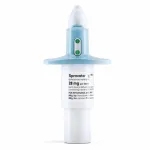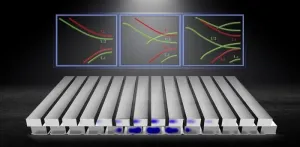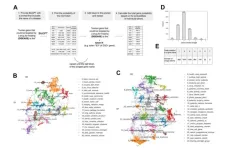(Press-News.org) Researchers from Memorial Sloan Kettering Cancer Center (MSK) were recognized for their achievements at the 2023 meeting of ASTRO, the American Society for Therapeutic Radiology and Oncology. Teams reported new findings about radiation-induced secondary cancers, a new guidance system for radiation therapy, and the consequences of insurance denials, among other topics.
At the meeting, held from October 1 to October 4, 2023, in San Diego, Simon Powell, MD, PhD, FRCP, Chair of MSK’s Department of Radiation Oncology and Enid A. Haupt Chair in Radiation Oncology, was honored with ASTRO’s Gold Medal Award. This award is ASTRO’s highest honor, bestowed upon esteemed members who have made exceptional contributions to radiation oncology, including research, clinical care, teaching, and service.
In addition, MSK experts shared their work in more than 40 presentations and poster sessions. These are some of the highlights.
Risk of Radiation-Induced Secondary Cancers in Patients With Li-Fraumeni Syndrome
Li-Fraumeni syndrome is a rare hereditary condition that leads to an increased likelihood of developing multiple types of cancer, including breast cancer and soft tissue sarcoma. It is caused by an inherited mutation in the gene TP53.
Research led by radiation oncology resident Gustav Cederquist, MD, PhD, used records from several hospitals to study the risk of secondary cancers in people with Li-Fraumeni syndrome who received radiotherapy as part of their treatment for breast cancer. The analysis included medical records from 91 patients, 40 of whom received radiotherapy. The investigators found that after 15 years, the risk of developing a sarcoma within the area where radiotherapy was delivered was 12%, compared with a 0.3% among a matched control group that was representative of the general breast cancer population receiving radiotherapy. They also found that for people with Li-Fraumeni syndrome, the overall risk of developing any secondary cancer within that 15-year time frame was approximately 50%, regardless of whether they received radiotherapy or not.
The researchers wondered why some breast cancer patients with Li-Fraumeni syndrome received radiotherapy and others did not. They found that those who received radiotherapy were more likely to have aggressive breast cancer characterized by larger tumors and lymph node metastases. Interestingly, the patients who received radiotherapy did not have decreased overall survival despite more aggressive breast cancer and an increased risk of secondary sarcoma. The authors therefore conclude that the added risk of the radiation treatment should be weighed against its benefits for controlling the original breast cancer, especially in patients with more advanced disease. The risk estimates from this study should help clinicians formulate personalized treatment decisions for patients with this rare cancer syndrome.
A New Guidance System for Radiation Therapy in Prostate Cancer
Investigators at MSK are always looking for ways to improve radiation therapy for treating prostate cancer and make it more precise. That is because when this treatment spreads to areas beyond the tumor, it can lead to problems like having to urinate more frequently.
A study led by former MSK radiation oncologist Michael Zelefsky, MD, and medical physicist Pengpeng Zhang, PhD, looked at whether a new guidance system developed at MSK was able to reduce these side effects by delivering the radiation more precisely. It focused specifically on a type of radiation called stereotactic body radiotherapy (SBRT). SBRT uses fiducial markers, metal objects about the size of a grain of rice, to help line up the beams of radiation.
The technique uses a new system called MKIG (for MV and kV imaging guidance), which was developed to track the location of fiducial markers and better correct for patients’ natural body movements during treatment. An analysis of 271 patients with cancer that had not spread beyond the prostate found that the MKIG system was practical for clinical use and reduced the number of urinary side effects. The researchers plan to continue studying the technique, including in other cancers where SBRT is used.
Consequences of Initial Insurance Denials for Radiation Therapy
Health insurance companies sometimes decline to authorize coverage for cancer treatments recommended by doctors, including radiation therapy. A study led by radiation oncologist Jacob Shin, MD, looked at data from more than 200 MSK patients who were denied coverage in 2022 to determine how those denials affected patients. The study also reported how many of those initial denials were ultimately overturned and what additional measures were needed to obtain treatment authorization.
The researchers found that of 206 cases:
127 patients were successful in eventually obtaining insurance authorization without having to make any changes to the treatment.
56 patients had their treatment authorized after their doctors agreed to modifications requested by the insurance company — lowering the dose of treatment or providing a different type of radiation.
23 patients did one of the following: proceeded with treatment via departmental administrative clearance (meaning MSK covered patients who couldn’t get coverage or the patient’s insurer eventually authorized treatment after the patient started radiation treatment), did not receive radiation treatment, or sought care at another institution.
Overall, a significant proportion of insurance denials led to delays in treatment, changes to the treatments that patients ultimately were able to receive, or both. The researchers say that there is a clear need for further investigation into the time and financial burdens caused by the increasing use of prior authorization by national insurers as well as the clinical impact of insurance denials on patient treatment and outcome. They want to establish more optimal ways to authorize and deliver radiation oncology care in a timely and cost-efficient manner.
END
Advances from MSK researchers reported at 2023 ASTRO Meeting
2023-10-04
ELSE PRESS RELEASES FROM THIS DATE:
Ketamine-related drug gives better treatment for difficult to treat clinical depression
2023-10-04
Type of work: peer-reviewed/clinical trial/people
A major clinical trial shows that the drug, esketamine, one of the two main forms of ketamine, outperforms one of the standard treatments for treatment-resistant major depression. This industry-funded work is presented for the first time at the 36th ECNP Congress in Barcelona, with publication in the peer-reviewed journal the New England Journal of Medicine (see Notes for details).
Clinical depression (also known as MDD, major depressive disorder) affects a significant number of people at any one time, giving ...
Esketamine nasal spray: an option for patients with treatment-resistant depression
2023-10-04
Understanding Treatment-Resistant Depression
Treatment-resistant depression (TRD) is a particularly challenging form of major depressive disorder. As Albino Oliveira-Maia, head of the Champalimaud Foundation’s Neuropsychiatry Unit and the study’s national coordinator for Portugal, explains, “TRD is defined as the persistence of depressive symptoms despite adequate courses of at least two different antidepressant medications”. Despite repeated therapeutic attempts, these patients’ depressive symptoms ...
Navigating moiré physics and photonics with band offset tuning
2023-10-04
When two lattices with distinct angles or periodicities come together, they conjure a moiré superlattice — a realm where astonishing phenomena like superconductivity and optical solitons spring to life. At the heart of this realm lies the moiré flatband, a key player in shaping advanced light–matter interactions, such as laser emission and second harmonic generation. In moiré physics and its relevant applications, wielding control over flatbands is a pivotal superpower.
Moiré flatbands are typically generated with special structures, often manipulated ...
Aging in place: U-M study highlights racial disparities among older adults
2023-10-04
Audio
Roughly 40% of older Black adults live with a disability, compared to only one-third of older adults overall.
Disability is one of various disparities highlighted in a new study from the University of Michigan, which used data from the National Poll on Healthy Aging to examine the extent to which 50- to 80-year-olds were prepared to age in place and the racial and ethnic disparities that exist to that end.
Sheria Robinson-Lane, U-M assistant professor of nursing and principal investigator, said many of the disparities were related to "weathering"—stressors connected to environmental, ...
U.S. drinking water often contains toxic contaminants, UNM scientist warns
2023-10-04
Most Americans take it for granted that the water that comes out of their taps is clean and safe to drink.
But a new study published by a University of New Mexico scientist with colleagues from across the U.S. warns that water from many wells and community water systems contains unsafe levels of toxic contaminants, exposing millions to health risks, including cancer.
The review in the Journal of Exposure Science and Environmental Epidemiology also finds that people living on tribal lands or ...
AI model for age-related disease target discovery
2023-10-04
“In this work, we focused on the application of the established pipeline to the identification of the potential targets related to aging [...]”
A new research paper was published in Aging (listed by MEDLINE/PubMed as "Aging (Albany NY)" and "Aging-US" by Web of Science) Volume 15, Issue 18, entitled, “Biomedical generative pre-trained based transformer language model for age-related disease target discovery.”
Target discovery is crucial for the development of innovative therapeutics and diagnostics. However, current approaches often face ...
Ruffed grouse population more resilient than expected, genetic study finds
2023-10-04
Despite decades of decline, a genetic analysis of ruffed grouse reveals that Pennsylvania’s state bird harbors more genetic diversity and connectivity than expected. The findings suggest that the iconic game bird could be maintained in persistent numbers if appropriate protections are implemented. The study, led by Penn State and Pennsylvania Game Commission researchers, published in the journal Molecular Ecology.
According to the researchers, Pennsylvania’s ruffed grouse populations have declined by up to 70% since the early ...
Ohio State awarded $20 million to put science behind tobacco product regulation
2023-10-04
The Ohio State University (OSU) has been awarded a $20 million Tobacco Center of Regulatory Science (TCORS) grant from the Food and Drug Administration’s (FDA) Center for Tobacco Products and National Institutes of Health.
The OSU-TCORS grant is a collaboration of experts from the colleges of medicine, public health and law organized and implemented through the Center for Tobacco Research at The Ohio State University Comprehensive Cancer Center – Arthur G. James Cancer Hospital and Richard J. Solove ...
Both high and low HDL cholesterol tied to increased risk of dementia
2023-10-04
EMBARGOED FOR RELEASE UNTIL 4 P.M. ET, WEDNESDAY, OCTOBER 4, 2023
MINNEAPOLIS – Having either high or low levels of high-density lipoprotein (HDL) cholesterol, or “good” cholesterol, is tied to a small increased risk of dementia in older adults, according to a study published in the October 4, 2023, online issue of Neurology®, the medical journal of the American Academy of Neurology. This study does not prove that high or low levels of HDL cholesterol cause dementia; it only shows an association.
“Previous studies on this topic have been ...
Meadow Spittlebug’s record-breaking diet also makes it top disease carrier for plants
2023-10-04
New research fueled in part by citizen scientists reveals that the meadow spittlebug—known for the foamy, spit-like urine released by its nymphs—can feed on at least 1,300 species of host plants, more than twice the number of any other insect.
The study, which is published today in the journal PLOS ONE, could be especially important in the effort to stop the bug from spreading a type of bacterium that has caused the death of crops across the world, including olive trees in Italy, grapevines in California, citrus trees in South America, and almond trees in Spain.
“Thirteen hundred host plants means 1,300 opportunities ...






